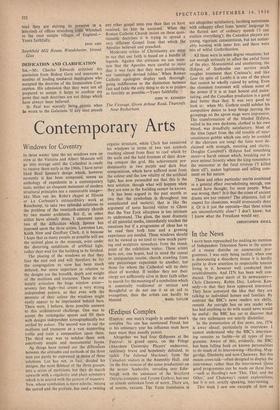Arts Contemporary
Windows for Coventry
IN three weeks' time the six windows now on view at the Victoria and Albert Museum will go into storage until the Cathedral is ready to receive them early in the 1960s. I have never liked Basil Spence's design which, however earnestly it has been composed, seems an anthology of expedients in a contemporary taste, neither an eloquent statement of modern structural principles nor a memorable image— like Mies van der Rohe's chapel at Illinois or Le Corbusier's extraordinary work at Ronchamp, to take two splendid solutions to the problem of the twentieth-century church by two master architects. But if, as other critics have already done, I comment upon two of the difficulties which Spence has imposed upon the three artists, Lawrence Lee, Keith New and Geoffrey Clark, it is because I hope that as many people as possible will see the stained glass in the museum, even under the distorting conditions of artificial light, rather than wait for the building to be finished.
The placing of the windows so that they face the east end and will therefore be for the congregation to view has been much debated, but more important in relation to the designs are the breadth, depth and weight of the mullions and transoms. These do not simply articulate the huge window areas— seventy feet high—but create a very strong independent pattern, so that even with the intensity of their colour the windows might easily appear to be imprisoned behind bars. There were, I believe, three possible answers to this architectural challenge. One was to accept the rectangular spaces and fill them with designs independent iconographically but unified by colour. The second was to use the mullions and transoms as a vast supporting trellis and train a composition upon them. The third way was to subdue them with assertively simple and monumental forms.
As things have turned out the differences between the attitudes and methods of the three men can partly be expressed in terms of these solutions. Lee has not. in fact, divided his designs, the most Biblical of the three groups. into a series of partitions, but they do march upwards with a, regularity and plain symmetry which is in accord with the pattern of masonry. New. whose symbolism is more eclectic, mixing the sacred and the profane, has used a twining
organic structure, while Clark has conceived his windows in terms of two vast symbols reaching almost from floor to roof which by the scale and the bold firmness of their draw- ing conquer the grid. His achievement pre- dominantly in two purple and dark blue compositions, which have suffered most from the colour and the low vitality of the artificial light, has now persuaded me that this is the best solution, though what will happen when they are seen in the building cannot be known.
It has been argued in the past month or two that the symbolism is throughout too complicated and esoteric; that is like the argument of some harried visitor to Ghent that the Van Eyck altarpiece is too intricate to understand. The glass, the most dramatic of all pictorial media, immediately touches the emotions but if a programme of ideas has to be read then both time and a growing experience are needed. These windows should rfot be viewed as we tend to view much paint- ing and sculpture nowadays, from the stand- point of the exhibition visitor. These artists have not, one hopes, had in mind the casual or antiquarian tourist, church crawling from one picturesque experience to another, but those for whom the Cathedral will be their place of worship. If neither they nor their clergy are sufficiently alive in their faith either to search for the meaning of a symbolism which is essentially traditional or serious and thoughtful or do not use it as an aid to evangelism, then the artists can hardly he


































 Previous page
Previous page